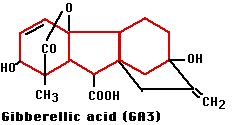
During the 1930s Japanese scientists isolated a growth-promoting substance from cultures of a fungus that parasitizes rice plants. They called it gibberellin.
After the delay caused by World War II, plant physiologists in other countries succeeded in isolating more than 30 closely-related compounds. One of the most active of these - and one found as a natural hormone in the plants themselves - is gibberellic acid (GA).
GA has a number of effects on plant growth, but the most dramatic is its effect on stem growth. When applied in low concentrations to a bush or "dwarf" bean, the stem begins to grow rapidly. the length of the internodes becomes so great that the plant becomes indistinguishable from climbing or "pole" beans. GA seems to overcome the genetic limitations in many dwarf varieties.
Genetic analysis of the dwarf wheat varieties that have played such an important part in the "green revolution" reveals that they carry mutant genes that reduce their ability to respond to their own gibberellins. These genes were introduced into wheat by the normal methods of plant breeding. However, a similar mutant gene (called gai) has been isolated from Arabidopsis and introduced into rice plants by genetic engineering. The resulting transgenic plants are shorter and sturdier than normal making them less likely to be damaged by wind and rain.
| One of the 7 pairs of traits that Mendel studied in peas as he worked out the basic rules of inheritance was dwarf-tall. The recessive gene - today called le - turns out to encode an enzyme that is defective in enabling the plant to synthesize GA. The dominant gene, Le, encodes a functioning enzyme permitting normal GA synthesis and making the "tall" phenotype. |
| Other plant hormones | ||||
|---|---|---|---|---|
| Abscisic acid (ABA) | Auxin | Cytokinins | Ethylene | |
| Welcome&Next Search |